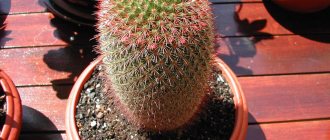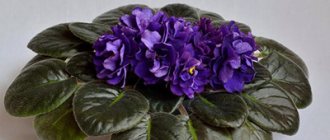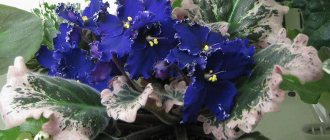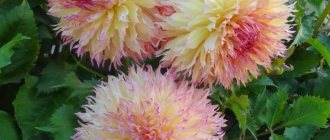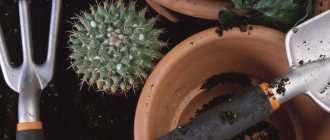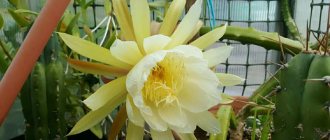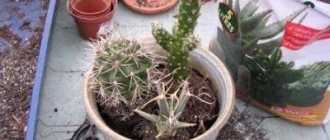The Internet is full of photos and articles about beautiful mountains, places, movies, etc. But unfortunately, so little is written about extraordinarily beautiful things. For example, about cacti. But beautiful cacti also deserve attention. The editors of most-beauty.ru decided to fill this small gap.
The family of these exotic plants includes almost three thousand species. What is surprising is that they have such a common feature as origin. They all come from America. Extreme conditions are not a problem for them at all. They store water and have a thick layer of skin, which allows them not to lose moisture and be able to stay even in very hot and dry places on the planet.
However, even among such unusual plants there are even more unique ones. In this article we will tell you about the most beautiful cacti in the world. So, let's go!
1
Astrophytum Medusa's Head
Photo credit: Resenter1/flicr
It has a unique shape and grows like the snake hair of a jellyfish. The seeds of this plant are quite large, as their diameter ranges from 3 to 6 millimeters. And the flowers have a typical color for this species - yellow with a red splash in the center.
2
Bird's nest (Mammillaria longimamma)
The bird's nest cactus is one of many subspecies of nipple cacti (Mammillaria). It is endemic to the Mexican states of Queretaro and Hidalgo. These are small cacti, growing from 8 to 24 cm and blooming with gorgeous yellow flowers. This cactus requires minimal water and soil rich in minerals. As they mature, they tend to grow in groups.
Lophophora Williams or Peyote
The plant has the shape of a ball, its diameter reaches only 8 centimeters. This cactus cannot be bought and grown at home. Cultivation is prohibited by law, since Peyote contains a fairly high concentration of mescaline (a substance with a psychedelic effect). But given the fact that the Lophophora Williams cactus has long played an important role in the rituals of Indian tribes, only members of these population groups are allowed to officially use this plant.
3
Hedgehog Cactus (Echinocereus triglochidiatus)
Other common names for this subspecies of cactus are kingcup cactus and Mojave cactus. It can survive in a wide range of climates, from deserts to mountain forests. These cacti are widespread in northern Mexico and southwestern America. Bright red flowers bloom from it in summer if it is watered frequently during this hot season. It is resistant to cold at temperatures down to -6 degrees.
Hylocereus wavy
Photo source: / CC BY-SA
This species is famous for its unusually beautiful flowers. Few people perceive cacti as flowers. But, looking at Hylocereus undulate, you can change this point of view once and for all. The length of the flower reaches almost forty centimeters, and the diameter is 25 centimeters. The peculiarity of this species is that it blooms exclusively at night, each flower of the plant opens only once.
In the photo: The fruit of Hylocereus wavy, which is edible and is an exotic fruit.
The flowers emit an incredibly pleasant vanilla aroma. However, you need to take into account that the aroma is pleasant only from a distance, since when directly inhaling the smell, it can turn out to be unbearable. Pictures that can be found on the Internet do not convey all the beauty of this plant, so you can only fully enjoy its beauty in person.
4
Creeping devil (Stenocereus eruca)
The creeping devil is a long, tubular succulent that contains an organic psychoactive substance called mescaline, as well as an organic subgroup of steroids called sterols. They have light green bodies and usually grow horizontally, making them a great addition to the garden. This species requires sandy soil and produces white flowers. It is endemic to the central Pacific coast of Baja California in Mexico.
Pereskiopsis spathulata
It is one of the cacti that grows very quickly. It is even used as a grafting base to increase the growth rate of seedlings of slow-growing species. This species is primitive in appearance. Both thorns and leaves grow from the same place. Therefore, it is most often used from a practical point of view.
5
Holiday Cactus (Schlumbergera truncata)
This cactus is also called the Thanksgiving Cactus and the Christmas Cactus, and is a subspecies of the Link Cactus. Its homeland is the tropical rain forests of the coastal mountain regions of southeastern Brazil. It is especially popular because of its large and bright flowers. It grows best in soil amended with sphagnum, a type of moss. It is drought tolerant and tends to live longer than most other cacti.
Turbinicarpus subterranean
An atypical, but beautiful cactus, since only small heads can be seen above the surface of the ground, which in their shape resemble a bat. However, underground it has roots that have the ability to store water and help the plant survive periods of drought. And in the cold season, the cactus is frost-resistant due to its underground location.
6
Spiny beavertail (Opuntia basilaris)
This is another flowering cactus known for its beautiful pink and purple flowers and elongated body that grows in clumps ranging from 30cm to 1m in height. Its homeland is the American southwest, including the Grand Canyon, the Colorado Plateau, western Arizona, southern Utah and Nevada, and northwestern Mexico. It is very drought tolerant and grows well in containers.
Blossfeldia dwarf
It is the smallest of all cacti on the planet. Blossfeldia dwarf grows from a depression located in the center of the plant, due to which a beautiful pattern appears as it grows. This plant blooms in the warm season - in summer, fertilizes itself, produces seeds. True, they are too small in size, so they often merge with the sand.
Those who decide to plant such a cactus in a pot at home will have to be patient. Since dwarf Blossfeldia is a very slow growing plant.
Home flowering cacti:
7
Basic rules of care
There are many varieties. Each specimen requires individual care. However, according to experts, there are general rules and schemes that must be strictly followed. Let's look at the recommendations in more detail.
How to grow
The process includes several stages. The first is choosing a suitable container. How to choose the right pot, and what criteria should it meet? The size of the device should be comparable to the parameters of the root system. It is enough to pull the plant out of the old pot, straighten the roots and examine them carefully. Some types have a more developed upper part. This indicates the need to choose wide dishes. The depth may be shallow.
If the roots grow in length, then you should look for a deep, but not wide container. In any case, the roots must be straightened. It is necessary to take into account that some space will be occupied by drainage.
What should you pay attention to when choosing the parameters of a flowerpot? If the plant is sick, it must be transplanted into a small pot. One cannot turn a blind eye to the peculiarities of growth and development of the root system in individual species. Thus, Mammillaria form a large number of children, so a lot of young animals appear in one container, which need free space. Therefore, it is worth choosing pots that are shallow but wide.
The material of the container, as well as its color, the presence of patterns and ornaments does not play any role. These characteristics depend on people's preferences. The main thing is that they are in harmony with the existing interior of the room. Usually plastic stands are purchased for them. Plastic sour cream cups, ceramic bowls, and coconut shells are also suitable. Experts recommend avoiding the use of metal devices. Over time, rust may appear on them, which will negatively affect subsequent growth and development.
The shape of the structure is of no small importance. If you are going to create a green oasis, then it is better to select square or rectangular boxes. They fit tightly to each other, saving free space.
Landing
You can plant one species at a time or several at once, creating interesting combinations. They are selected in such a way that the care and growing conditions are identical. Thus, experts do not recommend placing zygocactus and desert inhabitants in the same pot. Their water needs vary too much. Cereus develops so quickly that it can outshine its other brethren. Compositions made from representatives of different shapes will look beautiful. You can plant spherical species in the foreground, and columnar ones in the center. Place shells and pebbles around.
Spiny representatives must be handled with care. When transplanting, it is advisable to use kitchen tongs. To wrap the flower, you can use thick paper or leather. As for the soil mixture, it is worth giving preference to a depleted composition, which contains few nutrients. Such soil easily allows water to pass through. To create an optimal soil mixture, you can add foam chips or coarse sand. Also, a specialized earthen mixture is sold for them at retail outlets.
Choosing a location
The optimal place for placement is a window sill, where there is the most sunlight. They are installed on the lowest tier. Otherwise, you may encounter improper growth and development of the flower. A transformed stem will cause problems.
If the number of inhabitants exceeds the free space on the window sills, some can be relocated to a balcony or to a greenhouse located outside the window. Greenhouses in the country are also suitable. There the plants will feel excellent from spring to autumn. As soon as winter sets in, the flowers are moved indoors. They begin a period of hibernation. There is no need for excessive lighting, so a shaded place is suitable for them.
Features of watering
They need to create a special microclimate. Without proper watering, successful growth and development is impossible. The soil must be kept dry. Active growth occurs from March to September. At this time, watering should be rare and minimal. Do not allow the root system to rot. Plants are watered only if the soil becomes dry. During the hibernation period, watering is carried out once a month.
Warm, settled water is suitable for watering. There should not be any impurities in it.
There is no need to spray them. The shower is only suitable for certain categories. It is advisable to make the air in the room dry, but always fresh. Therefore, you should not skimp on ventilation.
Reproduction
Many people wonder: is it better to grow it with seeds or seedlings. It is worth noting that it is not advisable to use seeds at home. The process will be long and not always successful. But small cuttings root easily and quickly. For breeding, it is better to choose warm days, since the young animals will have to provide the correct temperature and humidity in the room. The cuttings are pre-dried and then placed in peat compost.
Where to buy planting material? You can do this in a specialized store or via the Internet by filling out an online application.
What you need to know about cacti propagation? Branches and “children” are involved in the process. The babies are carefully separated from the stem and dried for 14 days. Once the damaged edge has healed, it is placed shallowly in dry soil. When separating the baby, you must use a clean, sharp knife.
When cutting the stem, you need to remember the location of the tip. If planted incorrectly, growth and development will not be achieved. In order not to spoil the composition, the shoots are separated in such a way as not to harm the external characteristics of the mother plant.
The shoot should not be allowed to become affected by fungal soft rot. To avoid problems, you must listen to the following recommendations from experts:
- After separation, the shoot is placed in a dry and warm place for two weeks. The cut surface should be covered with callus. It minimizes the possibility of rotting.
- Before planting, the cuttings can be placed in garden sulfur. This will prevent the onset of rotting.
The first watering of young animals should be postponed for 7–10 days. Subsequently, the addition of liquid should be moderate and infrequent.
What to do if the plant is sick
The causative agents of diseases are fungi, bacteria, and viruses. Some diseases can be easily cured, while others will require some tinkering to prevent significant damage or death. Signs of the disease are not always on the surface. The disease can occur secretly, so it is not possible to detect it in time.
It is worth paying attention to the fact that preventing a disease is much easier than fighting it later. Especially if the plant is not one, but in a composition. We must not forget about preventive measures and keep flowers in hygienic conditions.
What causes diseases? He's not caring properly. There are other reasons for problems to arise:
- cool air entering the window;
- watering with cold water;
- the wounds are not sprinkled with crushed coal or sulfur in a timely manner;
- the pot is constantly in direct sunlight;
- the room is not kept dry and cool in winter.
What are the most common diseases of a cactus? Most often rot appears on the surface. This may be the result of a cold winter or overwatering. The source can be both fungi and bacteria. If the root system rots, damaged areas are urgently removed. The remaining roots are sprinkled with sulfur or coal powder. The soil must be completely replaced with fresh soil, adding coarse sand to it.
If a wound appears on the stem, it must be removed with a sharp knife. The damaged area is sprinkled with sulfur. If the damaged area is small, a scar may remain, but the plant will be saved.
Spotting has appeared - the result of drafts and high humidity. The stem becomes covered with a rusty crust. This may also be a consequence of sunburn. Once they appear, the spots begin to spread over the entire surface, spoiling the appearance of the plant. Spraying with a fungicide will help stop further spread. There is no point in removing crusts yourself. Ugly scars may remain.
Rhipsalis
Given this type of non-walking, this cactus will look like a regular cactus. It has the appearance of branching, succulent shoots of green-yellow color. The stems have aerial roots that are able to absorb moisture directly from the atmospheric air. The fruits of the cactus look like very small berries with a large number of black seeds. It blooms in the cold season with white, yellow or pink flowers.
9
Monk's Hood (Astophytum myriostigma)
This cactus blooms with gorgeous yellow flowers and is the largest and tallest species of its kind. Its homeland is the central plateau of Mexico. This species has white wooly flakes on the stem that protect it from the sun. This type of cactus requires chalky, rocky soil and some water, and can survive in dry conditions. It tolerates temperatures below 0 °C and is known for its long and cylindrical twisted body.
Echinopsis
The most common among cacti grown at home. It is completely unpretentious and is a very diverse species in its shapes and sizes. It is popular for its beautiful and large flowers. The petals can be arranged in several rows and are colored in shades of white, yellow, pink, orange and purple. The plant blooms starting in spring, flowering can last up to six months.
10
Tiny Rebutia (Rebutia miniscula)
These are small spherical cacti with a diameter of up to 10 cm. Rebutia differs from other spherical cacti in the location of the flowers - at the very base of the stem, and not at its top. The flowers of this cactus come in pink, red and orange tones. Even its golden spines are decorative.
Rebutia is tiny
Rebutia tolerates dry air, but it needs morning spraying from a small spray bottle. Otherwise, the plant needs the same conditions as other home cacti.
Rebutia is tiny
Rebutia is tiny
Epiphyllum
It blooms mainly in the warm season and has beautiful and massive flowers of various shades, the diameter of which is ten centimeters and sometimes exceeds it. Even by growing a cactus at home in a pot with artificial cross-pollination of flowers, you can get such large fruits, the pulp of which is edible and has a sweet pineapple-strawberry taste.
11
Morgan cactus (Sedum morganianum)
Also known as the donkey tail cactus, this succulent consists of small and round blue-green leaves. Pink and red flowers bloom from the leaves in summer. It grows wild exclusively on rocks in the tropical deciduous forests of eastern Mexico. Grows best in full sun and any well-drained soil. Extreme heat can be harmful to the plant, and in winter watering should be extremely rare.
Mammillaria
Small plants with shoots resembling clubs. Their peculiarity lies in their characteristic structure - in the form of numerous papillae, which can grow to form colonies.
Therefore, such a plant should be planted in wide and flat pots. They have a highly variable variety of flower colors that usually bloom in March, forming a crown around the top of the stem.
14
Schlumbergera or Christmas tree (Holiday Cactus)
The plant surprises with its flowering at an unusual time of year - in winter. There are snowdrifts outside the windows, and on your windowsill the Schlumberger is blazing with its bright flowers. Therefore, in winter this cactus requires intensive watering.
Christmas
The plant does not like direct sunlight, preferring diffused light. Flowers 6-8 cm long seem to be drooping, because they emerge from the upper part of shoots hanging down. Their color can be very diverse. A blooming Christmas tree is very nice to receive as a gift for New Year or Christmas!
Christmas
Subterrania parody
This species is reputedly almost entirely hidden under the soil (in its habitat) and is extremely difficult to find in the wild unless it is in flower.
The stem of the cactus has a spherical shape (sometimes slightly elongated vertically) and rarely branches. Size: 6-12 cm in diameter.
With proper care, this cactus will delight you with its pleasant blooms.
15
Blue ferocactus (Ferocactus glaucescens)
Ferocactus is a flowering plant whose diameter does not exceed 30-60 cm. They usually grow well alone and can be identified by their blue-green body and yellow flowers. This species is endemic to the limestone hills of Hidalgo, Mexico. Requires well-drained soil and partial shade. In winter they must be stored in dry conditions at temperatures above 10 °C.
Selenicereus grandiflora
Selenicereus grandiflora is a species of cactus native to the Antilles, Mexico and Central America. This species is commonly called the Night Queen, although the term is also used for other species. The flowers of this plant are large, up to 30 cm in diameter. They have a pleasant vanilla scent and, as you can see, are very beautiful.
Mammillaria
Thanks to its simple care, this species is very popular and loved by gardeners. The plant is covered with soft and long needles similar to hairs. Mammillaria has about 500 species. They differ from each other in the structure of the stem: cylindrical, spherical.
Mammillaria
Mammillaria
Mammillaria differs from other representatives of the Cactus family by the presence of a large number of papillae on the stem. Flowers of red, purple , and snow-white shades appear from the axils between the papillae.
Mammillaria
Mammillaria
Mammillaria
conclusions
There are many different types of cacti on the planet. Each of them is unique in its own way and is able to endure the harshest climatic conditions to give a unique beauty in a place where no other plant can do so.
The editors of most-beauty.ru ask you to write in the comments which beautiful cacti, in your opinion, should also be on this list.
Editor's note: This article has been updated since its original publication in October 2022.
Prickly pear
Coming from North and South America, prickly pear is a completely unusual type of cacti. Unlike most other cacti, prickly pear is a tree that grows large “leaves” covered in spines. An ancient Aztec legend is associated with this tree. According to it, the Aztec capital Tenochtitlan (now known as Mexico City) was founded on a site where a prickly pear grew, on which an eagle sat and ate a snake. It is this picture that is depicted on the coat of arms of Mexico.
Since those times, prickly pear fruits have been used as food for people, and in recent years they are increasingly used as feed for livestock. In addition, prickly pear is used to extract the natural red dye carmine. It is obtained from the Mexican cochineal insect, which is cultivated on prickly pear cacti.
Trichocereus candicans
Can grow up to 1.5 meters. It features white, funnel-shaped, fragrant flowers.
Depending on the species, the stem can grow vertically or obliquely. The length of the spines on the ribs reaches 4 cm, in the center - 2 times longer.
The plant is very hardy and unpretentious, gaining height and expanding easily with plenty of sunlight, warmth and regular watering.
Schlumbergera cactus
A tropical resident brought to cold Europe from the hot Brazilian shores. A striking feature of the species is its soft and safe spines. Most flower growers know this cactus as the “Decembrist”. This is due to the flowering period of the plant - the height of the New Year holidays.
The shape of the flowers of such cacti resembles beautiful orchids. The color range of the blooming buds is also striking - from dazzling white to dark purple and burgundy. If everything goes well, they bloom all winter.
Cacti are desert dwellers, but they cannot tolerate direct sunlight. It is better to choose a habitat for these flowers away from southern windows. It is easy to identify a burn that has already been received - the color of the plant will noticeably lighten.

